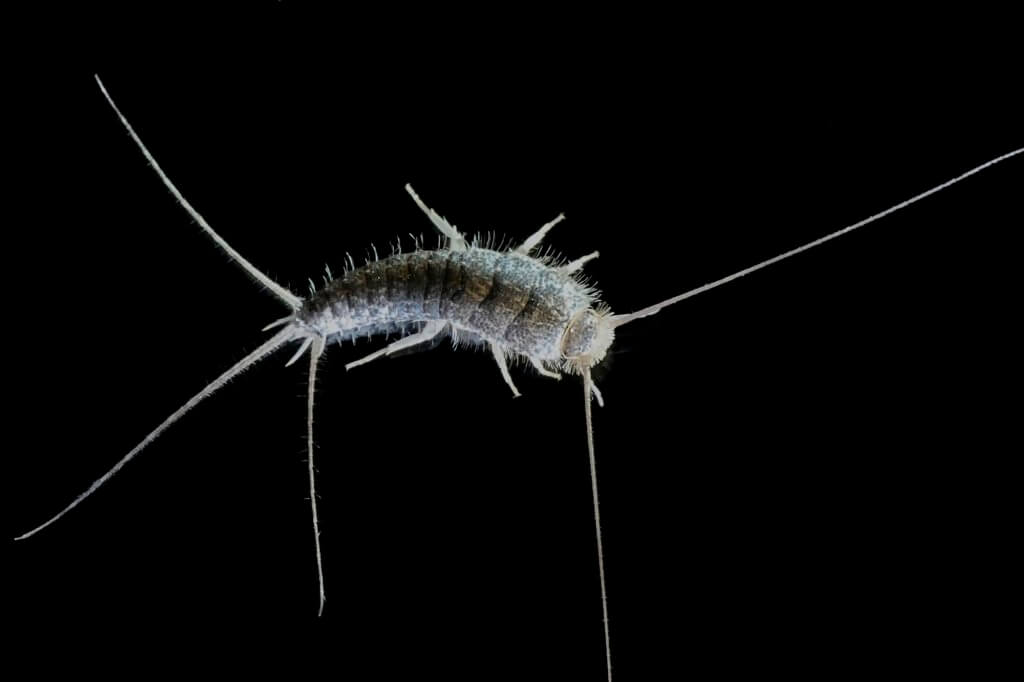Silverfish are small little silver-colored insects that can be found inside and around your home. While they are relatively small and harmless bugs, they aren’t a pest you want to see crawling in your home. Discover how to get rid of silverfish in your home naturally with Gunter Pest Control and Lawn Care.
What are Silverfish Attracted To?
Figure out how to get rid of silverfish naturally by figuring out what they are attracted to. Silverfish are commonly located in the United States.
They can be found across the country from Missouri to Ohio, to Florida. In their outside habitat, they are near rocks, logs, and other dark crevices and holes. They are resilient, able to survive in a variety of different environments and climates.
Similar to their outside environment, when they are in your home, silverfish enjoy small dark and damp areas. These areas include basements, bathrooms, attics, kitchen cabinets, and they live beneath sinks. If left unchecked, these silverfish will cause an infestation!
What do Silverfish Eat?
Every insect has to eat. Another method to understanding how to get rid of silverfish naturally is to know what they eat.
If silverfish find food inside your house, they will most likely never leave. They enjoy starchy foods, flour, wool, clothing materials, and paper – all things commonly found inside your house. They would love to snack on a piece of bread.
You can identify their presence in your closets by looking to see if there are tiny black droppings. Look for shells where they shed their skin, or small holes and yellow stains in your clothing items or paper products.
If you aren’t careful, silverfish will eat you out of clothes, paper, and food.
What’s the Danger of Silverfish?
Other than eating all your papers and fabrics, or looking creepy as they glide across the floor. What are the dangers of silverfish? Silverfish do not transmit diseases or bite, but they attract many insects and predators that do.
Earwigs, spiders, and centipedes are all-natural predators of silverfish. If your house is a hub for silverfish, then its predators will find their way inside your home too. Left unchecked they will damage your belongings and will attract insects that can bite, transmit diseases. These other household pests can be even scarier than silverfish.

How to Get Rid of Silverfish Naturally or In a Safe Way
If you see a silverfish, it’s advised to dispose of it on-site. There are multiple ways and methods on how to get rid of silverfish naturally and in a safe way.
- Minimize Entryways: Keep your screen doors and windows closed during the summer months. Make sure everything is closed tightly as these small creatures can slip through the smallest cracks.
- Inspect Your Home & Clean-Up Damp Areas: Make sure there are not any damp areas from leaky pipes or leaking areas. Additionally, inspect your closets, attic, and basement to make sure they don’t already have a nest made.
- Apply Natural Repellents in areas or even storage containers where you commonly see silverfish. Apply fresh cedar shavings, cinnamon, cloves, or even cucumber peels to repel silverfish. We recommend putting them in socks or bags so that they do not ruin your items. Change these out every so often to keep fresh.
- Utilize Dehumidifiers Utilize dehumidifiers throughout your house, attic, basement, and closets. As previously mentioned, silverfish enjoy humid, damp, and dark areas. Using a dehumidifier can prevent them from congregating in your house.
- Keep Your House Clean Keep your home clean, free of crumbs, or foods that could be seen as potential food sources. These may also ruin silverfish nests.
- Call a Pest Control Company Utilize a pest control company to prevent pests from coming back and destroying your home. If you have an infestation, you won’t be able to get rid of these yourself. Call professional silverfish exterminators in order to fix your infestation. Utilize the natural pest control options listed above to keep your home safe from another infestation.
Silverfish FAQ:
Q: Do LED lights attract silverfish?
A: LED lights do not attract silverfish. These insects are not drawn to light sources like some other pests such as moths or flies. Instead, silverfish prefer dark, damp environments such as basements, attics, and bathrooms.
Q: Can cats eat silverfish?
A: Yes, cats can eat silverfish. Silverfish are small insects that some cats may find intriguing to chase and consume. However, it’s important to note that while silverfish aren’t typically harmful to cats, they’re not a recommended part of a cat’s diet. Ingesting silverfish in large quantities could potentially cause gastrointestinal upset in cats.
Q: Are silverfish harmful to dogs?
A: Silverfish are not typically harmful to dogs. These insects are not known to carry diseases that can affect dogs, and they are unlikely to cause any direct harm to your pet. However, if a dog ingests a large number of silverfish, it could potentially lead to stomach upset or vomiting due to the unusual food source.
Q: Do silverfish eat money?
A: No, silverfish do not eat money. Despite their name, silverfish do not consume metals like silver or coins. Silverfish are primarily attracted to starchy substances such as paper, glue, and certain fabrics like cotton and linen. While they may cause damage to items containing these materials, they do not have any interest in money specifically.
Natural Pest Control with Gunter Pest Control
Gunter Pest and Lawn Care specialize in eco-friendly pest control services in Missouri. We are committed to sustainability and have taken steps to make our services more efficient and green. We installed solar panels on our buildings, utilizing electric vehicles, and moving to natural pest control.
Be Sure To Check Out Our Services:
Termites — Mosquitoes — Spiders — Bed Bugs








